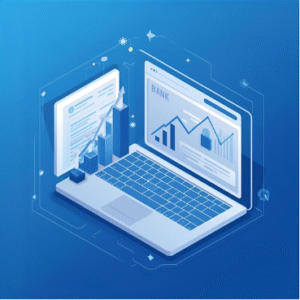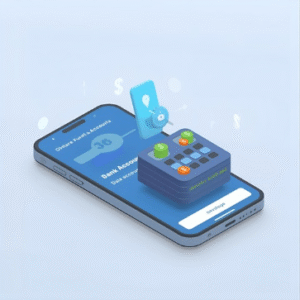Introduction to Online Banking Security
Online banking has transformed the way people manage their finances, providing unmatched convenience and accessibility. However, with this convenience comes the responsibility of ensuring your account remains safe from potential threats. Cybercriminals use increasingly advanced methods to target online bank accounts, making it essential to understand how to minimize risks. Whether you’re logging in to check balances, transfer money, or pay bills, taking measures to protect your sensitive information should always be a top priority. Recognizing potential vulnerabilities and adopting good security practices can help you stay one step ahead of online threats.

Use Strong and Unique Passwords
When creating a password for your online bank account, ensure it is both strong and unique to provide maximum protection. A secure password is typically long, consisting of at least 12 characters, and includes a combination of uppercase and lowercase letters, numbers, and symbols. This complexity makes it significantly harder for attackers to guess or crack. Avoid using easily identifiable information such as your name, phone number, or commonly used phrases, as these are often the first attempts made by hackers. Additionally, steer clear of reusing passwords across multiple accounts. Using the same password for various sites or services can expose your online bank account to higher risks, especially if another account is breached.
A helpful strategy for managing strong, unique passwords is to use a reliable password manager. These tools not only generate complex passwords but also store them securely, reducing the need to remember multiple combinations. This minimizes the temptation to create overly simple passwords that could jeopardize your account’s security. Password managers can also help you update your passwords periodically, further enhancing the safety of your sensitive information.
Another essential practice is avoiding passwords that follow predictable patterns, such as sequences like “1234” or keyboard patterns like “qwerty.” These types of passwords are among the first tested in automated hacking attempts. Instead, focus on crafting passphrases that are harder to decode, such as a random string of unrelated words mixed with symbols and numbers. For example, a phrase like “Elephant!Moon_45Tree” is both memorable and secure.

Remember to keep your passwords private and avoid sharing them, even with people you trust. Additionally, steer clear of saving passwords in browsers or writing them down in places where others might access them. For added safety, update your passwords immediately if you suspect any account may have been compromised. A well-chosen password acts as a barrier against unauthorized access, reducing the likelihood of your account becoming a target for cybercriminals.
Enable Two-Factor Authentication
Two-factor authentication (2FA) enhances the security of your online bank account by adding an additional verification step beyond your password. This method ensures that even if your password is compromised, unauthorized users cannot easily access your account without the second form of identification. Common types of 2FA include SMS codes sent to your mobile device, authenticator apps like Google Authenticator or Authy, and biometric options such as fingerprint or facial recognition.
When possible, opt for app-based authentication instead of SMS codes, as app-based options are generally more secure and less vulnerable to interception. Many banks also offer hardware tokens, which generate unique codes for every login attempt, further reducing the risk of unauthorized access. Explore your bank’s settings to enable 2FA and choose the option that best fits your needs.
Some banks allow you to set up backup methods for 2FA, such as alternative devices or recovery codes. Be sure to save these recovery codes in a secure location, as they may be required if your primary 2FA method becomes unavailable. Additionally, stay cautious of prompts asking you to disable 2FA. Cybercriminals sometimes attempt to bypass security by tricking users into turning off extra protection. Always verify such requests with your bank directly to ensure they are legitimate.
Incorporating 2FA into your online banking habits provides a reliable safeguard against unauthorized access, offering peace of mind as you manage your finances online.
Monitor Account Activity Regularly
To maintain control over your online bank account, it’s important to keep a close eye on your account activity. Set aside time to review your transactions frequently, as this allows you to quickly identify any unusual charges or unauthorized activity. If you notice something that doesn’t seem right, notify your bank immediately to prevent further issues.
Most banks provide tools to make this process easier, such as customizable alerts. These notifications can be sent directly to your phone or email, alerting you to activity like large withdrawals, purchases made in unfamiliar locations, or changes to your account settings. Taking advantage of these alerts ensures you’re informed about account activity in real time, giving you an opportunity to act quickly if something seems suspicious.
Many financial institutions also offer detailed transaction histories through their online platforms, helping you track your spending and confirm that all transactions were initiated by you. Cross-referencing this information with receipts or personal records can help catch discrepancies you might otherwise overlook. When reviewing your account, pay special attention to smaller charges you don’t recognize. Hackers sometimes test stolen accounts with small transactions before attempting larger ones.

Additionally, take the time to ensure your contact information is up to date with your bank. Providing a current phone number and email address allows you to receive alerts and account updates without delay. If you notice that your contact details have been changed without your knowledge, contact your bank immediately to secure your account.
Another useful strategy is signing up for paperless statements if your bank offers them. Digital statements are less likely to fall into the wrong hands than physical mail, which can be intercepted or misplaced. This extra step can help protect your financial information while still giving you full access to your account records.
Finally, avoid accessing your bank account through shared or public devices whenever possible. Using a trusted device for routine checks minimizes the risk of exposing your credentials to malicious software or unauthorized users. Remaining consistent in these practices can help you better manage your account and address concerns before they escalate.
Be Wary of Phishing Scams
Phishing scams are a deceptive tactic used by cybercriminals to trick individuals into sharing sensitive information, such as login credentials or financial details. These scams often mimic legitimate communications from banks or other trusted entities, making them difficult to recognize at first glance. You might receive emails, text messages, or even phone calls designed to create a sense of urgency, pushing you to act quickly without fully analyzing the situation.
One common tactic is the use of fake links embedded in emails or messages that redirect you to a fraudulent website resembling your bank’s official site. These counterfeit sites are designed to capture the information you enter, such as your username and password. Always inspect links carefully before clicking, and hover over them to check the actual URL. If the address seems unusual or doesn’t match your bank’s official website, it’s best to avoid interacting with it altogether.
Cybercriminals may also include attachments in phishing emails, claiming they contain important documents like account statements or payment confirmations. These attachments often harbor malware that can infect your device and compromise your account. Never download or open attachments from unknown senders, especially if the email seems suspicious or unsolicited.
Another red flag is the use of generic greetings, such as “Dear Customer,” rather than addressing you by name. Legitimate correspondence from your bank will typically include personalized details, such as your name or partial account number. Additionally, phishing messages frequently contain spelling or grammatical errors, which can indicate that they are not from a professional source.
When in doubt, contact your bank directly using a verified phone number or email address found on their official website. Avoid using the contact information provided in the suspicious message, as it may be part of the scam. It’s also a good idea to report phishing attempts to your bank and relevant authorities to help prevent others from falling victim to the same scam.
Staying cautious when handling unsolicited messages and carefully verifying the authenticity of any communication claiming to be from your bank can help you avoid falling prey to phishing scams.
Secure Your Devices
Ensuring the safety of the devices you use for online banking is a vital step in protecting your financial information. Begin by regularly updating the operating system and software on your devices, as these updates often include important security patches that address newly discovered vulnerabilities. Failing to update can leave your device exposed to malware or unauthorized access.
Another critical measure is installing reputable antivirus software to detect and block threats before they compromise your data. Choose a program that offers real-time protection and regularly scans for potential risks. Some antivirus programs also include features like anti-phishing tools, which can provide an added layer of security during online transactions.
When accessing your online bank account, make sure your device is protected with strong authentication methods. Use unique passcodes, patterns, or biometric options like facial recognition or fingerprint scans to lock your device. These measures prevent unauthorized users from gaining access if your device is lost or stolen.
Public Wi-Fi networks should be avoided when performing sensitive activities like banking. These networks are often unsecured, making it easier for cybercriminals to intercept your data. If you must access your account on the go, consider using a virtual private network (VPN) to encrypt your connection and keep your information private.

Disable unnecessary features like Bluetooth and file sharing when they are not in use, as these can serve as entry points for hackers. Similarly, review the apps installed on your devices to ensure they come from trusted sources. Malicious apps disguised as legitimate ones can secretly collect sensitive information or compromise your security.
Pay attention to the browser you use for banking. Make sure it’s up to date and verify that the website connection is secure by checking for a padlock icon in the address bar. Avoid saving login credentials in your browser, as these can be vulnerable to exploitation.
Finally, enable remote wipe features on your devices if available. This allows you to erase sensitive data from your device if it is ever lost or stolen, reducing the risk of unauthorized access to your online banking information.
Conclusion
Taking steps to protect your online bank account is crucial in today’s digital age. Consistently practicing good security habits can go a long way in minimizing risks and keeping your sensitive information safe. Whether it’s using strong passwords, enabling two-factor authentication, or carefully monitoring account activity, these measures collectively help fortify your financial security.
In addition to these practices, staying vigilant against scams and maintaining secure devices plays a vital role in preventing unauthorized access. Cybercriminals are constantly evolving their tactics, which is why staying informed about emerging threats and adopting new security measures is essential. Educate yourself on how to identify phishing attempts, and don’t hesitate to report anything suspicious to your bank or relevant authorities.
It’s also worth taking advantage of any security tools and resources offered by your bank, such as account alerts or enhanced authentication options. These tools can provide added reassurance by helping you address potential issues before they escalate.
Ultimately, prioritizing your online banking security doesn’t just protect your financial accounts—it also provides peace of mind, ensuring you can confidently manage your finances in an increasingly digital world.
